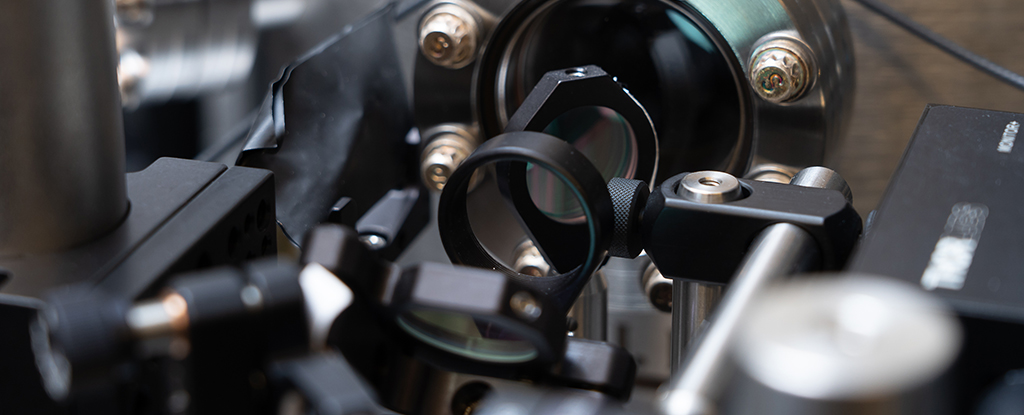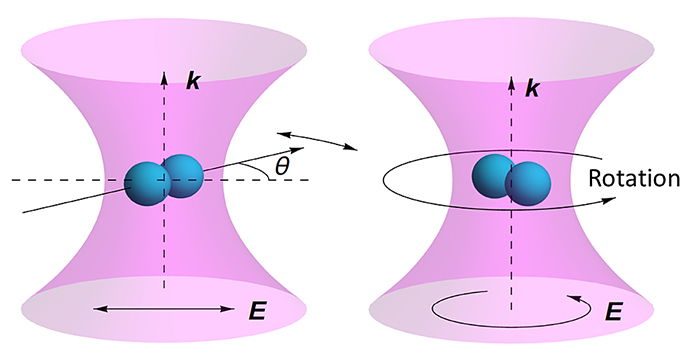Skip to comments.
This Is The Fastest Rotor Humans Have Ever Built, And It's Bending Our Understanding of Physics
Science Alert ^
| 24 JUL 2018
| DAVID NIELD
Posted on 07/26/2018 11:43:06 AM PDT by Heartlander
This Is The Fastest Rotor Humans Have Ever Built, And It's Bending Our Understanding of Physics
Mind-boggling.
Scientists have created a tiny rotor that rotates at speeds of up to 60 billion revolutions a minute – the fastest-spinning human-made rotor in history, and 100,000 times faster than your average dental drill.
The record-breaking invention not only pushes the boundaries of physics but could also be used to study some of the mysteries of quantum mechanics, and how objects operate in a vacuum.
We're actually dealing with some of the fundamentals of science here, like how gravity and friction work in a vacuum. Now that the nano-rotor is up and running, some detailed investigations can begin, according to the team of researchers.
"This study has many applications, including material science," says senior researcher Tongcang Li from Purdue University in Indiana. "We can study the extreme conditions different materials can survive in."
The super-spinner is made up of a silica nanoparticle, shaped like a dumbbell and levitated in a vacuum using a laser. The laser can be polarised in a straight line or in a circle, and its the circular mode that produces the rotations.
When the laser is straight, the dumbbell vibrates rather than rotating – which means it can consequently be used to measure very weak forces. Both modes of operation are going to be useful for future research.
The nanoparticle itself is only about the size of a bacterial particle, around 170 nanometres wide and 320 nanometres long, so you can't see it with the naked eye. But this is what the setup looks like:
 (Purdue University photo/Vincent Walter)
(Purdue University photo/Vincent Walter)
"People say that there is nothing in vacuum, but in physics, we know it's not really empty," says Li.
"There are a lot of virtual particles which may stay for a short time and then disappear. We want to figure out what's really going on there, and that's why we want to make the most sensitive torsion balance."
 Vibrate and spin modes. (Purdue University photo/Tongcang Li)
Vibrate and spin modes. (Purdue University photo/Tongcang Li)
One of the advantages of getting a nanoparticle suspended and rotating in a vacuum like this is that very precise measurements can be made, unaffected by the standard variations in air flow and temperature.
And this team isn't the only one busy working on getting nanoparticles rotating in a vacuum: the potential discoveries further down the line are substantial.
As for quantum mechanics, it helps scientists explain the behaviour of the Universe at the very small and the really big scales – areas where the classical physics model as we know it starts to fall down.
Having such a tiny object to experiment on should give is a better understanding at how the building blocks of matter work at the tiniest scales.
In other words, you might be hearing a lot more about this nanoscale rotor in the future.
The research has been published in Physical Review Letters
TOPICS: Education; Science
KEYWORDS:
Navigation: use the links below to view more comments.
first previous 1-20, 21-40, 41-60, 61-80, 81-82 next last
To: raybbr
Let alone balancing it before spinning to said high speeds. Actually, only the purely balanced ones can survive those speeds. Good luck finding one. :-)
61
posted on
07/26/2018 1:28:51 PM PDT
by
SgtHooper
(If you remember the 60's, YOU WEREN'T THERE!)
To: Heartlander
That deserves a WOW.
5.56mm
62
posted on
07/26/2018 1:37:34 PM PDT
by
M Kehoe
... a tiny rotor that rotates at speeds of up to 60 billion revolutions a minute – the fastest-spinning human-made rotor in history, and 100,000 times faster than your average dental drill. If a dental drill spun at 600,000 RPM, it would be out the bottom of your jaw, or top of your head, before the dentist could say "open wide."
Who edits this stuff?
63
posted on
07/26/2018 1:46:32 PM PDT
by
Henchster
(Free Republic - the BEST site on the web!)
To: snarkpup
I was thinking of some things somewhat less ambitious, like a propeller.
To: Calvin Locke
Of note, a pure synchronous electric motor must set spinning at a proper rotation speed to sync with the applied electrical input, thereby maintain rotation. It is not self-starting.
The optically driven rotor likely is not synchronous with the light applied. The circularly polarized light does manage to provide an offset momentum kick to the rotor ends, which results in rotation from startup.
To: fishtank
Way cool!
“The White–Juday warp-field interferometer is an experiment designed to detect a microscopic instance of a warping of spacetime. If such a warp is detected, it is hoped that more research into creating an Alcubierre warp bubble will be inspired.”
“The Alcubierre drive remains a hypothetical concept with seemingly difficult problems, though the amount of energy required is no longer thought to be unobtainably large.”
https://en.wikipedia.org/wiki/Alcubierre_drive#Alcubierre_metric
66
posted on
07/26/2018 2:12:03 PM PDT
by
BenLurkin
(The above is not a statement of fact. It is either satire or opinion. Or both.)
To: raybbr
Perhaps the rotor/light interaction changes the polarization of a reference light source. The differential then allows determining the rotation rate.
To: Fido969
Boy, what’s the torque like on that baby?
I’m thinking it will need lots of gear for the holeshot.
68
posted on
07/26/2018 2:14:42 PM PDT
by
DUMBGRUNT
(This Space for Rent)
To: ImJustAnotherOkie
60 billion RPM’s. How do you measure that?
A non-contact tachometer.
But it would have to go to ELEVEN, or maybe higher?
69
posted on
07/26/2018 2:17:57 PM PDT
by
DUMBGRUNT
(This Space for Rent)
To: DUMBGRUNT
It’s the force of the laser times the distance between the axis and the end of the little crystal thingy.
A small number times another really small number.
The momentum, however is the mass times the velocity.
Even though the weight of the little crystal thingy is small, the angular velocity of this bad boy is pretty massive.
That wouldn’t be such a super small number, but it would still be small.
To: NorthMountain
Just a mini radiometer, pumped up by lasers.
I have an old Crooks radiometer around here somewhere(next to the drinking bird).
Hit it with a laser and it would surely spin extra fast.
71
posted on
07/26/2018 2:26:31 PM PDT
by
DUMBGRUNT
(This Space for Rent)
To: wally_bert
When can I get one at Harbor Freight?
Just look for a Crooks radiometer on Amazon.
72
posted on
07/26/2018 2:29:54 PM PDT
by
DUMBGRUNT
(This Space for Rent)
To: RinaseaofDs
A small number times another really small number.
I’m thinking, that is a polite way of saying that any real-world advantage, would be eaten by friction loss?
73
posted on
07/26/2018 2:36:11 PM PDT
by
DUMBGRUNT
(This Space for Rent)
To: Tenacious 1
The part spinning at a rate exceeding the speed of light is supposed to increase infinitely in size. No?
74
posted on
07/26/2018 2:37:56 PM PDT
by
Getready
(Wisdom is more valuable than gold and diamonds, and harder to find.)
To: Pride in the USA
I think it’s way cool, even though way above my pay grade. Still, I’ll keep watching for the future theories, applications, and discoveries that result. Along the way, some genius-level physicist who’s able to explain these things to mere mortals invariably turns up. FUN!
75
posted on
07/26/2018 2:46:46 PM PDT
by
lonevoice
(diagonally parked in a parallel universe)
To: Heartlander
By my rule-of-thumb calculation, an object 320nm long being rotated would have a path whose outer circumference is about 1 micrometer.
So 60B rotations / sec would be 60M meters per second (at the outer edge).
Or around 37000 miles per second.
That’s about 20% light speed.
Perhaps others here can double-check my math.
76
posted on
07/26/2018 2:46:47 PM PDT
by
unlearner
(A war is coming.)
To: DUMBGRUNT
In this case, there would be zero friction loss, or near zero friction loss because this contraption is in a vacuum.
The folks doing this experiment claim vacuums aren’t really empty, and there ARE some particles in vacuums. If that’s true, the number can’t be zero friction.
However, consider that 68 billion revolutions is 6.8 x 10^10, and that happens per second. Multiply that by 2 x pi, and that’s the distance the end of the little spinner goes in one revolution. So the v is 10^11 nm/s, roughly. That’s a big number, but what is the mass of the little crystal thingy you multiply that v number with? 10^-9 grams? Who knows, maybe less? The momentum would be in the hundreds of nm g/s. Not a huge number.
To: rjsimmon
Maybe measuring an electrical field created by lots of electrons moving around and around and around...
To: raybbr
60 gigahertz. It’s measurable, in the upper end of the microwave part of the spectrum. I work with radars for tank level measurement that operate around 23 GHz.
79
posted on
07/26/2018 4:15:12 PM PDT
by
Fred Hayek
(The Democratic Party is now the operational arm of the CPUSA)
To: 2ndDivisionVet
80
posted on
07/26/2018 7:58:00 PM PDT
by
Sawdring
Navigation: use the links below to view more comments.
first previous 1-20, 21-40, 41-60, 61-80, 81-82 next last
Disclaimer:
Opinions posted on Free Republic are those of the individual
posters and do not necessarily represent the opinion of Free Republic or its
management. All materials posted herein are protected by copyright law and the
exemption for fair use of copyrighted works.
FreeRepublic.com is powered by software copyright 2000-2008 John Robinson
 (Purdue University photo/Vincent Walter)
(Purdue University photo/Vincent Walter) Vibrate and spin modes. (Purdue University photo/Tongcang Li)
Vibrate and spin modes. (Purdue University photo/Tongcang Li)